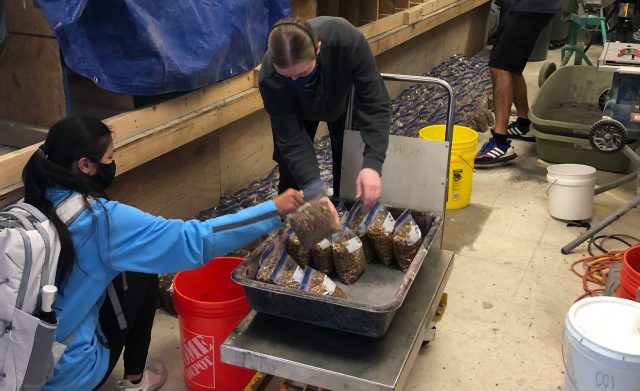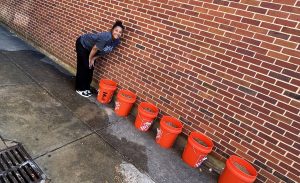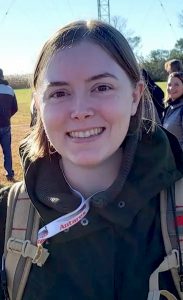
Grace Rushing (center), a civil engineering lecturer at the university, and a student prepare aquifer kits for high school classrooms as part of the Grisham-McLean Institute for Public Service and Community Engagement’s MPartner program. A $100,000 grant from the Environmental Protection Agency will allow the institute and two university researchers to deliver testing kits to high school students across north Mississippi. Submitted photo
OXFORD, Miss. – The University of Mississippi is partnering with north Mississippi schools this year to offer enrichment about water quality and citizen science projects around water testing in the community.
The Environmental Protection Agency is funding the project with a $100,000 grant. In August, the EPA announced it will provide $3.1 million to 33 organizations across the country to promote environmental education.
The project is led by Matteo D’Alessio, assistant professor of civil engineering; Laura Martin, associate director of the Grisham-McLean Institute for Public Service and Community Engagement; and Grace Rushing, civil engineering lecturer. Together, the group will provide training, research opportunities and more than 300 reusable STEM kits to six north Mississippi high schools.

Ole Miss student Micah Smith, a senior integrated marketing communication major from Belden, checks out components being used in the EPA-funded water quality testing project in north Mississippi schools. Submitted photo
“We are so grateful to our K-12 partners for permitting us the opportunity to build on our partnerships and add this dimension of environmental education to our collaboration,” Martin said. “This project will support local knowledge and develop skills to promote environmental stewardship.”
Participating schools include:
- Holly Springs High School
- North Panola High School
- North Pontotoc High School
- Pontotoc High School
- South Pontotoc High School
- Water Valley High School
Through the yearlong project, high school students will learn about water resources and quality, test samples from their communities and tour the Oxford campus. Three Ole Miss students – Shakiara Campbell, a junior from Louin majoring in social work; Micah Smith, a senior from Belden majoring in integrated marketing communication; and Cecylia Williams, a junior civil engineering major from Bay St. Louis – will assist in the project.
Each of the STEM kits includes reusable water activities and testing equipment that can be used for up to 10 years. This will allow teachers to integrate water quality testing into their classes each year, D’Alessio said.
“Students will learn and simulate the water cycle, how to extract ground water, the influence of pesticides and other chemicals” D’Alessio said.
While learning about water quality, students will also be collecting real data about the resources in their communities, Rushing said.
“We want to heavily emphasize the community aspect,” she said. “It will give them an up-close-and-personal experience with the quality of water where they live.”
Loretta Hartfield, federal programs director for the Pontotoc County School District, said this project gives students an opportunity to become engaged in the science of the world around them.
“I think the students are going to have a keen interest in this because this water is what they’re using to clean and bathe and cook,” Hartfield said. “This experience will help students regardless of what they want to do in the future.
“I feel like they will have a better understanding and a higher motivation to pursue, to advance this idea.”
Students can take their results to community leaders, present them at Mississippi State University’s annual Water Resources Conference and better understand their surrounding environment, D’Alessio said.
“We want the students to be able to use the data they create,” he said.
The grant aligns with the EPA educational priority of involving increasing public awareness and developing community projects on local environmental issues.
“We want to introduce STEM to students with hands-on activities that allow them to engage directly with the environment around them,” Rushing said. “They can get out of the classroom and see where the data comes from.”
Throughout the project, the principal investigators also hope students will find a love of science, technology, engineering and mathematics, or STEM, fields, community engagement or education.
“Some students may not have any idea that they’re interested in science,” Rushing said. “What I hope is that this makes them excited, this makes them see a place like the university and think, ‘I can see myself here. I can succeed in this environment.’
“We know not everyone wants to be an engineer, but maybe they learn that they want to be able to advocate for their community.”
Many of the schools selected for the project were already partners of the university through M Partner, an ongoing initiative that unites Mississippi communities with university resources to produce internships, learning experiences and service opportunities, and the North Mississippi VISTA Project, a national service program funded by the federal AmeriCorps agency that builds capacity for organizations devoted to poverty alleviation.
This project also builds on a longstanding partnership between the Grisham-McLean Institute and educators in the North Panola School District.
“We are grateful to have this partnership,” Hartfield said. “We have cherished the partnership we’ve had with the Grisham-McLean Institute.”
This project has been funded wholly or in part by the U.S. Environmental Protection Agency under assistance agreement 02D46823 to Matteo D’Alessio. The contents of this report do not necessarily reflect the views and policies of the Environmental Protection Agency, nor does the EPA endorse trade names or recommend the use of commercial products mentioned in this document.


